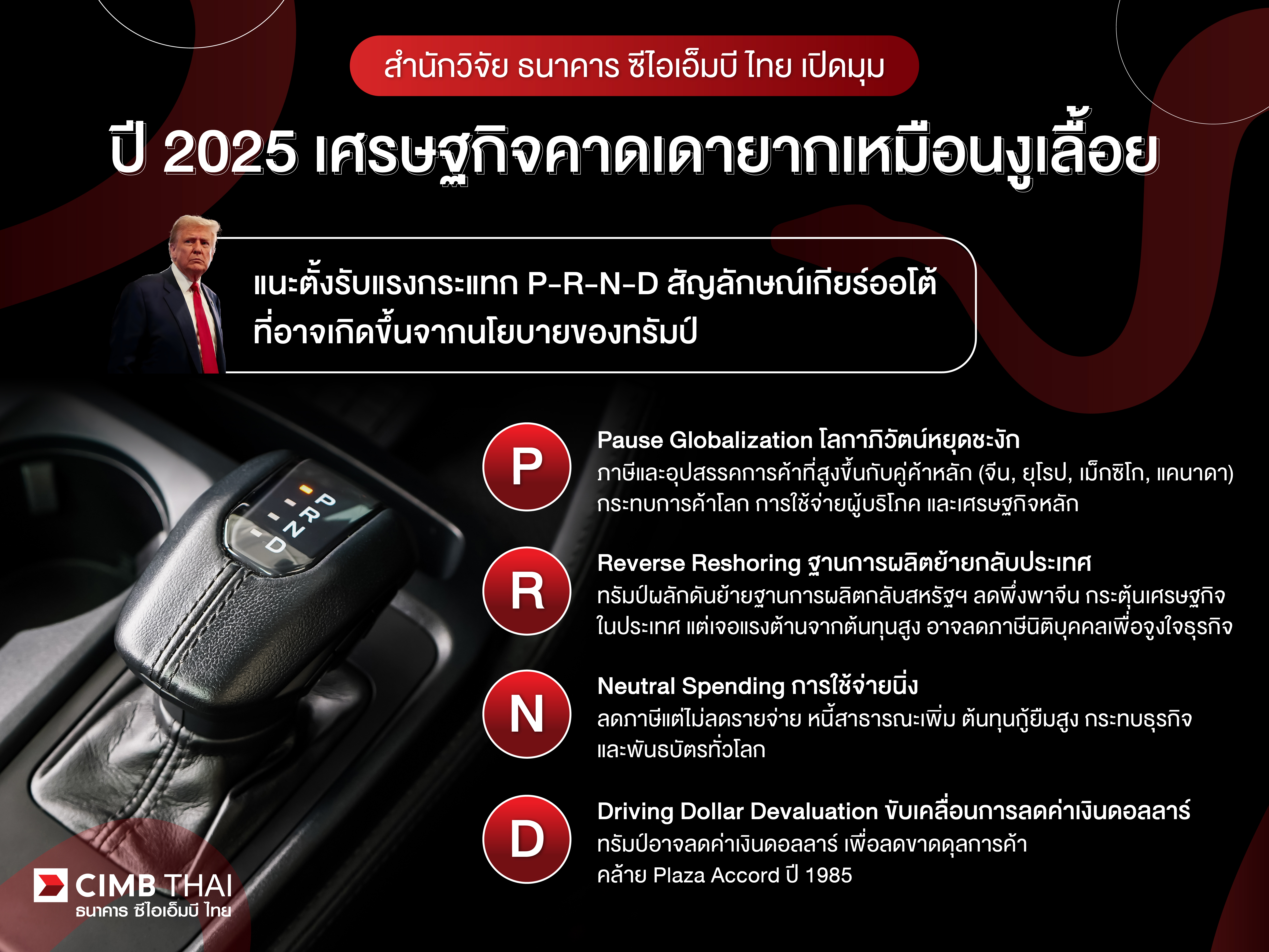ปี 2025 เศรษฐกิจคาดเดายากเหมือนงูเลื้อย แนะตั้งรับแรงกระแทก P-R-N-D สัญลักษณ์เกียร์ออโต้ ที่อาจเกิดขึ้นจากนโยบายของทรัมป์

ปี 2025 เศรษฐกิจคาดเดายากเหมือนงูเลื้อย
แนะตั้งรับแรงกระแทก P-R-N-D สัญลักษณ์เกียร์ออโต้
ที่อาจเกิดขึ้นจากนโยบายของทรัมป์
ดร.อมรเทพ จาวะลา ผู้ช่วยกรรมการผู้จัดการใหญ่ ผู้บริหารสำนักวิจัย ธนาคาร ซีไอเอ็มบี ไทยเปิดเผยว่า เศรษฐกิจไทยปี 2025 เปรียบได้กับงูที่ใส่เกียร์เดินหน้าเลื้อยคดบนถนนเศรษฐกิจ จากภูมิทัศน์เศรษฐกิจโลกกำลังเปลี่ยนแปลงและซับซ้อนภายใต้การบริหารของประธานาธิบดีทรัมป์ ไทยจำเป็นต้องปรับตัวและรับมือกับความท้าทาย โดยได้รับแรงหนุนจากปัจจัยภายในประเทศ ได้แก่ การใช้จ่ายด้านการท่องเที่ยว การแจกเงินจากภาครัฐ และการฟื้นตัวของการลงทุนภาคเอกชน เป็นปัจจัยหลักขับเคลื่อนการเติบโตของเศรษฐกิจไทยในปี 2025 แม้จะมีแรงกดดันจากปัจจัยภายนอก สำนักวิจัยฯ คาดว่าเศรษฐกิจไทยจะเติบโตที่ 2.7%

เลื้อยคดบนถนนเศรษฐกิจไทยปี 2025
- การใช้จ่ายด้านการท่องเที่ยว การฟื้นตัวและขยายตัวต่อเนื่องของอุตสาหกรรมท่องเที่ยวยังเป็นจุดเด่น จากนักท่องเที่ยวที่เพิ่มขึ้นและค่าใช้จ่ายต่อหัวที่สูงขึ้นโดยเฉพาะจากตลาดยุโรปและเอเชีย โดยคาดว่าจำนวนนักท่องเที่ยวจะเพิ่มขึ้นแตะ 39.1 ล้านคนในปี 2025 ซึ่งสูงกว่าที่คาดการณ์ไว้ 35.6 ล้านคนในปี 2024 แต่ยังต่ำกว่าจำนวน 39.9 ล้านคนในปี 2019 แม้จำนวนนักท่องเที่ยวจากจีนยังไม่ถึงระดับก่อนโควิด แต่นักท่องเที่ยวชาติอื่น ๆ ใช้จ่ายเพิ่มขึ้นทั้งค่าโรงแรมและร้านอาหาร ส่งผลเชิงบวกต่อโรงแรมระดับ 4 และ 5 ดาว รวมถึงที่พักสไตล์บูติก ขณะที่โรงแรมระดับ 3 ดาวในแหล่งท่องเที่ยวสำคัญจะยังฟื้นตัวช้ากว่า
- โครงการแจกเงินจากภาครัฐ เพื่อกระตุ้นการบริโภคของครัวเรือนและลดภาระค่าครองชีพมีส่วนช่วยกระตุ้นการบริโภคภาคเอกชนในปี 2025 โดยเฉพาะในภาคบริการและสินค้าไม่คงทน
- การลงทุนภาคเอกชนที่ฟื้นตัว โดยเฉพาะในอุตสาหกรรมอิเล็กทรอนิกส์ ยานยนต์ไฟฟ้า (EVs) และแบตเตอรี่ โดยได้รับแรงหนุนจากการย้ายฐานการผลิตและโอกาสใหม่ในอาเซียน นอกจากนี้ การลงทุนในโครงสร้างพื้นฐานด้านการคมนาคมและพลังงานจะช่วยกระตุ้นกิจกรรมในภาครัฐและเอกชน เสริมสร้างความเชื่อมั่นของนักลงทุนต่างชาติ อย่างไรก็ตาม แม้ว่าการลงทุนภาคเอกชนจะมีแนวโน้มเพิ่มขึ้น แต่ธุรกิจขนาดกลางและขนาดย่อม (SMEs) ของไทยอาจยังเผชิญกับความท้าทายในการปรับตัวให้เข้ากับห่วงโซ่อุปทานของจีน รวมถึงต้องรับมือกับการแข่งขันที่รุนแรงขึ้นจากผู้ประกอบการจีน
แม้ว่าจะมีปัจจัยขับเคลื่อนการเติบโต แต่ก็ยังมีปัจจัยเหนี่ยวรั้งการเติบโตของเศรษฐกิจไทย อาทิ กำลังซื้อของครัวเรือนรายได้น้อยอ่อนแอ การส่งออกที่ฟื้นตัวช้า และตลาดอสังหาริมทรัพย์ที่ยังคงซบเซา
- กำลังซื้อของครัวเรือนรายได้น้อยอ่อนแอ โดยเฉพาะกลุ่มที่พึ่งพารายได้จากภาคการเกษตร ยังคงเผชิญกับความยากลำบากจากรายได้ภาคการเกษตรที่ลดลงและหนี้ครัวเรือนที่อยู่ในระดับสูง ซึ่งจำกัดความสามารถในการใช้จ่าย แม้รัฐบาลจะมีโครงการโอนเงินช่วยเหลือเพื่อสนับสนุนกลุ่มผู้มีรายได้น้อยก็ตาม
- การส่งออกยังคงฟื้นตัวช้า โดยได้รับผลกระทบจากความตึงเครียดทางการค้าโลกและความต้องการที่ลดลงจากตลาดสำคัญ เช่น จีนและอาเซียน ซึ่งเป็นอุปสรรคต่อแนวโน้มการค้าโดยรวม
- ตลาดอสังหาริมทรัพย์ยังคงซบเซา โครงการก่อสร้างใหม่มีจำกัด การลงทุนในอุตสาหกรรมที่เกี่ยวข้องลดลง โดยเฉพาะในตลาดคอนโดมิเนียมที่มีราคาต่ำกว่า 3 ล้านบาทต่อหน่วย ซึ่งความต้องการยังคงอยู่ในระดับต่ำ
ความท้าทายบนเส้นทางข้างหน้า: PRND
ปีงู 2025 อาจสะท้อนถึงความไม่แน่นอนและความไม่สามารถคาดเดาได้ ทำให้การคาดการณ์เป็นเรื่องยาก นักลงทุนควรเตรียมตัวรับมือกับการเปลี่ยนแปลงที่อาจเกิดขึ้นจากนโยบายของทรัมป์ เพื่อให้สามารถก้าวผ่านปีงูไปได้อย่างราบรื่น ในที่นี้ ขอใช้สัญลักษณ์ของเกียร์อัตโนมัติ (PRND) ที่แสดงถึงแรงกระแทกที่อาจเกิดขึ้นจากนโยบายของทรัมป์ ดังนี้
- การหยุดชะงักของโลกาภิวัตน์ (Pause Globalization) ทรัมป์อาจพิจารณาการเรียกเก็บภาษีที่สูงขึ้นอย่างมากเพื่อลดการขาดดุลการค้าในประเทศกับคู่ค้าการค้าหลักของสหรัฐฯ ได้แก่ แคนาดา เม็กซิโก ยุโรป และจีน ภาษีและอุปสรรคทางการค้าที่เพิ่มขึ้นเหล่านี้อาจทำให้การค้าและการลงทุนทั่วโลกหยุดชะงักได้ และอาจทำให้โลกาภิวัตน์สะดุดลง การดำเนินมาตรการเหล่านี้อาจส่งผลกระทบต่อการใช้จ่ายของผู้บริโภคและลดการเติบโตทางเศรษฐกิจในเศรษฐกิจหลักๆ ซึ่งอาจเพิ่มความไม่แน่นอนทางเศรษฐกิจทั่วโลก
- การย้ายฐานการผลิตกลับประเทศ (Reverse Reshoring) ทรัมป์ต้องการนำงานในภาคการผลิตกลับมายังสหรัฐฯ เดิมทรัมป์ต้องการย้ายฐานการผลิตจากจีนไปยังประเทศพันธมิตร หรือ "friend-shoring" แต่ระยะถัดไปทรัมป์น่าจะมุ่งเป้าหมายไปที่การนำงานมูลค่าสูงกลับเข้าสู่สหรัฐฯ โดยตรง เพื่อกระตุ้นการผลิตและการบริโภคภายในประเทศ และลดการพึ่งพาจีน แม้การย้ายโรงงานมายังสหรัฐฯ อาจเผชิญความท้าทายด้านต้นทุนแรงงานที่สูงจนกระทบความสามารถในการแข่งขัน เราเชื่อว่าทรัมป์จะเสนอลดภาษีนิติบุคคลเพื่อจูงใจธุรกิจ และกำหนดอัตราภาษีสูงเพื่อลงโทษบริษัทที่ไม่ปฏิบัติตาม
- การใช้จ่ายที่นิ่ง (Neutral Spending) แม้ทรัมป์วางแผนลดภาษี แต่ไม่มีแผนลดการใช้จ่ายต่าง ๆ รวมถึงยังอาจมีค่าใช้จ่ายเพิ่มเติมจากนโยบายควบคุมการอพยพครั้งใหญ่ ซึ่งอาจกดดันเสถียรภาพทางการคลังของสหรัฐฯ มาตรการทางการคลังเหล่านี้ทำให้อัตราผลตอบแทนพันธบัตรรัฐบาลระยะยาวของสหรัฐฯ ปรับตัวเพิ่มขึ้นอย่างรวดเร็ว เนื่องจากนักลงทุนกังวลเกี่ยวกับหนี้สาธารณะที่เพิ่มสูงขึ้น ต้นทุนการกู้ยืมที่สูงขึ้นอาจสร้างความท้าทายอย่างมีนัยสำคัญต่อการจัดหาเงินทุนของภาคธุรกิจ นอกจากนี้ อัตราผลตอบแทนพันธบัตรรัฐบาลระยะยาวของสหรัฐฯ ยังมีอิทธิพลต่ออัตราผลตอบแทนพันธบัตรรัฐบาลของประเทศในภูมิภาคนี้ ซึ่งหมายความว่าพันธบัตรรัฐบาลไทยและบริษัทในประเทศอาจเผชิญกับต้นทุนการกู้ยืมที่สูงขึ้นในอนาคตอันใกล้
- การขับเคลื่อนการลดค่าเงินดอลลาร์ (Driving Dollar Devaluation) แม้เราคาดว่าเงินดอลลาร์สหรัฐฯจะแข็งค่า แต่ทรัมป์อาจพลิกมุมมองนี้ด้วยการดำเนินนโยบายลดค่าเงินดอลลาร์ ที่ผ่านมา เขาได้ตรวจสอบแนวทางการค้าของคู่ค้าสหรัฐฯ อย่างต่อเนื่อง โดยกล่าวหาว่าบางประเทศมีการแทรกแซงค่าเงินและขู่จะเก็บภาษีตอบโต้ ทรัมป์อาจมองว่าเงินดอลลาร์มีมูลค่าสูงเกินไป ซึ่งเป็นสาเหตุสำคัญที่ทำให้สหรัฐฯ มีการขาดดุลการค้าจำนวนมาก มุมมองนี้อาจนำไปสู่การดำเนินกลยุทธ์คล้ายกับ Plaza Accord ในปี 1985 โดยกดดันประเทศผู้ส่งออกสำคัญให้ปรับค่าเงินให้แข็งค่าเทียบกับเงินดอลลาร์
เศรษฐกิจไทยปี 2024
สำนักวิจัยฯ ได้ปรับประมาณการ GDP ไทยปี 2024 เพิ่มขึ้นจาก 2.3% เป็น 2.6% จากเศรษฐกิจไตรมาส 3 ที่ขยายตัวดีเกินคาดที่ 3.0% YoY รวมถึงผลจากนโยบายการแจกเงินช่วงปลายไตรมาส 3 ที่ขยายผลต่อเนื่องถึงไตรมาส 4 โดยคาดว่า GDP ไตรมาสสุดท้ายจะอยู่ที่ 3.7% YoY หรือ 0.5% QoQ หลังปรับฤดูกาล (QoQ,SA) ซึ่งได้รับแรงสนับสนุนจากนโยบายการแจกเงินของรัฐบาลเพื่อกระตุ้นการบริโภค โดยเฉพาะในกลุ่มครัวเรือนที่มีรายได้ต่ำ
ปัจจัยขับเคลื่อนหลักเป็นภาคบริการที่เกี่ยวกับการท่องเที่ยว เช่น โรงแรม ร้านอาหาร การขนส่ง และอาหารและเครื่องดื่ม นอกจากนี้ กิจกรรมก่อสร้างภาครัฐเริ่มเพิ่มขึ้นในครึ่งหลังของปี 2024 ขณะที่การส่งออกยังขยายตัวได้ โดยเฉพาะในอิเล็กทรอนิกส์ อาหารแปรรูป และผลิตภัณฑ์การเกษตร
อย่างไรก็ตาม ดัชนีผลผลิตภาคอุตสาหกรรม (MPI) ยังอ่อนแอ ส่งผลลบต่อการเติบโตของค่าจ้างและโอกาสการจ้างงาน แม้เราได้ปรับประมาณการเศรษฐกิจขึ้น แต่เศรษฐกิจไทยยังมีแนวโน้มซบเซาจากปัจจัยต่าง ๆ อาทิ การเบิกจ่ายงบประมาณที่ล่าช้าในช่วงครึ่งแรกของปี 2024 กำลังซื้ออ่อนแอในกลุ่มครัวเรือนรายได้ต่ำ และตลาดอสังหาริมทรัพย์ที่ซบเซา นอกจากนี้ ยอดขายรถยนต์ลดลงมาก ส่วนหนึ่งเกิดจากการเข้ามาแข่งขันด้านราคาของรถยนต์ไฟฟ้า (EV) ความเชื่อมั่นของผู้บริโภคที่ต่ำ และการถูกปฏิเสธสินเชื่อในอัตราสูง โดยเฉพาะกลุ่มประวัติการเงินหรือเครดิตไม่ดี ด้านกำลังซื้อกลุ่มครัวเรือนเกษตรกรรายได้ต่ำยังอ่อนแอ ได้รับผลกระทบเพิ่มเติมจากอุทกภัยฉับพลันและสภาพอากาศเลวร้ายกลางปี 2024 ผลผลิตการเกษตรลดลง ท่ามกลางระดับหนี้ครัวเรือนที่สูงอยู่ก่อนหน้า
ด้านการเงิน ธนาคารแห่งประเทศไทย (ธปท.) คงดอกเบี้ยนโยบายที่ 2.25% ตามคาด เพื่อประเมินผลกระทบจากการลดดอกเบี้ยเดือนตุลาคม ค่าเงินบาทคาดว่าจะทรงตัวอยู่ที่ประมาณ 34.50 บาทต่อดอลลาร์สหรัฐฯ ช่วงปลายปี 2024 คาดว่าเฟดจะปรับลดดอกเบี้ยจาก 4.75% เหลือ 4.50% ช่วยลดส่วนต่างดอกเบี้ยไทยและสหรัฐฯให้แคบลง
แนวโน้มอัตราดอกเบี้ยและอัตราแลกเปลี่ยน
ธปท. คงดอกเบี้ยนโยบายไว้ที่ 2.25% หลังปรับลดลง 25 bps เดือนตุลาคม เพื่อประเมินผลกระทบจากการปรับลดดอกเบี้ยและติดตามการส่งผ่านของนโยบายการเงินต่อเศรษฐกิจ อย่างไรก็ตาม คาดว่าธปท.จะปรับลดดอกเบี้ยนโยบายลงเพิ่มเติมจาก 2.25% เป็น 1.50% ภายในสิ้นปี 2025 โดยมีปัจจัยสำคัญ 5 ประการที่เป็นแรงผลักดัน ได้แก่ การส่งออกที่ฟื้นตัวช้ากว่าที่คาด ผลผลิตภาคอุตสาหกรรมที่อ่อนแอ อัตราเงินเฟ้อที่ลดลง รายได้ภาคเกษตรที่ลดลง และความจำเป็นในการรักษาความสามารถในการแข่งขันด้วยการปล่อยค่าเงินอ่อนค่า ซึ่งปัจจัยสุดท้ายถือเป็นปัจจัยสำคัญอย่างยิ่ง เนื่องจากสะท้อนถึงความเสี่ยงที่สงครามการค้าอาจลุกลามเป็นสงครามค่าเงิน
สำหรับอัตราเงินเฟ้อปี 2025 มีแนวโน้มที่จะไม่ถึงกรอบเป้าหมายของ ธปท. ที่ 1-3% ส่วนใหญ่เป็นผลจากราคาน้ำมันลดลง โดยคาดว่าทรัมป์จะกดดันราคาน้ำมันโลกให้ลดลงเพื่อควบคุมเงินเฟ้อในสหรัฐฯ ผ่านการเพิ่มการผลิตน้ำมันและก๊าซจากชั้นหินดินดาน (shale oil) ภายในประเทศ หรือการคลี่คลายความตึงเครียดทางภูมิรัฐศาสตร์ในรัสเซียและตะวันออกกลาง คาดว่า ธปท. จะยุติการปรับลดดอกเบี้ยภายในไตรมาสที่ 3 ของปี 2025 สอดคล้องกับการพักการปรับลดดอกเบี้ยของเฟด โดยการตัดสินใจของเฟด อาจได้รับอิทธิพลจากความกังวลเกี่ยวกับการเพิ่มขึ้นของเงินเฟ้อที่เกิดจากการลดภาษีและการเพิ่มการใช้จ่ายของทรัมป์
เงินบาทคาดว่าจะอ่อนค่าลงเล็กน้อยเมื่อเทียบกับดอลลาร์สหรัฐ จากการไหลออกของเงินทุนไทยไปตลาดหุ้นในสหรัฐฯ ที่ได้รับประโยชน์จากนโยบายการปรับลดอัตราภาษีนิติบุคคลของทรัมป์ รวมถึงการโยกสินทรัพย์ตลาดเกิดใหม่ไปสินทรัพย์ในรูปดอลลาร์สหรัฐฯ ตามการเพิ่มขึ้นของผลตอบแทนพันธบัตรรัฐบาลสหรัฐฯ แม้ว่าการอ่อนค่าของเงินบาทจะช่วยเพิ่มขีดความสามารถการแข่งขันด้านการส่งออก แต่ก็อาจเพิ่มต้นทุนการนำเข้า ก่อให้เกิดความท้าทายต่อธุรกิจที่พึ่งพาวัสดุที่นำเข้าจากต่างประเทศ โดยคาดว่าเงินบาทจะอยู่ที่ 34.50 บาทต่อดอลลาร์สหรัฐปลายปี 2024 ก่อนที่จะอ่อนค่าลงต่อไปที่ 35.00 บาทต่อดอลลาร์สหรัฐในปี 2025
Slithering on Thailand’s Economic Road 2025
Dr. Amonthep Chawla
Executive Vice President and Head of Research, CIMB Thai Bank
Better-than-expected growth in 3Q24
We have revised our 2024 GDP growth projection upward from 2.3% to 2.6%, following a stronger-than-expected 3.00% year-on-year (yoy) growth in the third quarter and the impact of cash handout policies introduced in the late third quarter, extending into the fourth quarter. We now expect GDP growth for the final quarter to reach 3.7%yoy or 0.5% quarter-on-quarter (qoq, sa), driven by continued government cash transfers to stimulate consumption, especially among low-income households.
Key growth drivers remain tourism-related services, such as hotels, restaurants, transportation, and food and beverages. Public construction activity has picked up in the second half of 2024, while exports have shown strong growth, particularly in electronics, processed foods, and agricultural products.
However, the manufacturing production index (MPI) remains weak, which could dampen wage growth and employment prospects. Despite the upward revision to the growth forecast, Thailand’s economic performance is expected to remain subdued, mainly due to delayed budget disbursement in the first half of 2024, weak purchasing power among low-income households, and a sluggish real estate market. Additionally, car sales have fallen sharply, partly due to the competitive pricing of electric vehicles, low consumer confidence, and high loan rejections, particularly among those with poor credit histories. Purchasing power among low-income agricultural households remains weak, exacerbated by flash floods and poor climate conditions in mid-2024, which reduced farm output on top of already high household debt levels.
On the financial front, the Bank of Thailand (BOT) maintained the policy rate at 2.25% to assess the effects of the first rate cut in October. The Thai baht is projected to remain around 34.50 baht per US dollar towards the end of 2024, influenced by an anticipated US rate cut from 4.75% to 4.50%, which would reduce the interest rate differential between the US and Thailand.
Slithering on Thailand’s Economic Road 2025
The evolving global economic landscape under President Trump demands greater adaptability and precise navigation to manage the twists and turns of the challenging year ahead in 2025. Thailand’s economy is projected to grow by 2.70%, driven by a combination of steady domestic factors and persistent external headwinds.
Key growth drivers for Thailand in 2025 include tourism spending, public cash transfers, and recovering private investment. First, the ongoing recovery and expansion of tourism remain a key bright spot, driven by increased arrivals and higher per capita spending, particularly from European and Asian markets. Tourist arrivals are projected to reach 39.1 million in 2025, surpassing the forecasted 35.6 million for 2024 but slightly below the 39.9 million recorded in 2019. While major tourist nationalities, apart from the Chinese, have exceeded pre-COVID levels, they are also spending more on hotels and restaurants. This benefits 4- and 5-star hotels, as well as boutique accommodations, while 3-star hotels in major tourist areas are expected to recover at a slower pace. Second, government cash transfer programs aimed at stimulating household consumption and mitigating living costs are likely to boost private consumption in 2025, particularly in services and non-durable goods. Third, private investment is set to rebound, particularly in sectors such as electronics, electric vehicles (EVs), and batteries. This recovery is supported by industry relocations and new opportunities in ASEAN. Infrastructure investments in transportation and energy will further stimulate activity in both the public and private sectors, bolstering foreign investor confidence. However, while private investment is expected to rise, Thai SMEs may struggle to fully capitalize on the shift, as they face difficulties integrating into Chinese supply chains and increased competition from Chinese counterparts.
Despite these growth drivers, significant challenges could weigh on Thailand’s economic prospects, including weak purchasing power among low-income households, sluggish exports, and a stagnant real estate market. First, low-income households, especially those reliant on agriculture, face persistent struggles due to declining farm incomes and elevated household debt. This limits their ability to spend, despite the government’s cash transfer programs aimed at supporting the poor. Second, export recovery remains slow, constrained by global trade tensions and subdued demand from key markets such as China and ASEAN. These headwinds continue to dampen the overall trade outlook. Third, the real estate sector remains sluggish, with limited new construction projects and reduced investment in related industries. This is particularly evident in the condominium segment priced below 3 million baht per unit, where demand remains weak.
Outlook for interest rate and FX
The Bank of Thailand (BOT) maintained the policy rate at 2.25% in December, following a 25bps cut in October, to assess the impact of the rate reduction and monitor the transmission of monetary policy to the economy. However, we expect the BOT to lower the policy rate further, from 2.25% to 1.50% by the end of 2025, driven by five key factors: slower-than-expected export performance, weak manufacturing production, softening inflation, declining farm income, and the need to remain competitive amid weakening currencies. The last factor is particularly critical, as it indicates the potential escalation of a trade war into a currency war. Inflation in 2025 is unlikely to reach the BOT’s target range of 1-3%, largely due to falling oil prices. President Trump is expected to exert downward pressure on global oil prices to curb U.S. inflation, either by ramping up domestic shale oil and gas production or by resolving geopolitical tensions involving Russia and the Middle East. The BOT is expected to halt rate cuts by Q3 2025, aligning with a possible pause in the U.S. Federal Reserve’s rate-cut cycle. The Fed’s decision to pause may be influenced by concerns over rising inflation fueled by Trump’s tax cuts and expansive spending policies.
The Thai baht is expected to weaken moderately against the U.S. dollar due to capital outflows driven by U.S. equities benefiting from Trump’s corporate tax cuts, as well as a shift away from emerging market assets toward U.S. dollar-denominated investments amid rising U.S. bond yields. While this depreciation could enhance export competitiveness, it may also raise the cost of imports, creating challenges for businesses reliant on imported materials. By the end of 2024, the Thai baht is projected to stabilize at 34.50 baht per U.S. dollar, before further weakening to 35.00 baht per U.S. dollar in 2025.
Conclusion: Challenges Road Ahead: PRND
The Year of the Snake in 2025 could embody both uncertainty and unpredictability, making it difficult to rely on what we foresee. To navigate this volatile period, it is essential to prepare for the disruptions that may arise from Trump’s policies, enabling us to move through the Year of the Snake with resilience and calm. We use the symbols of an automatic car gear to represent the potential shocks of Trump’s policies: PRND, explained as follows.
P stands for Pause Globalization. Trump may consider imposing significantly higher tariffs to reduce trade deficits with key U.S. trading partners, including Canada, Mexico, Europe, and China. These increased tariffs and trade barriers could disrupt global trade and investment flows, potentially stalling globalization. Such measures could also strain consumer spending and dampen economic growth in major economies, amplifying economic uncertainties worldwide.
R stands for Reverse Reshoring. Trump is a strong advocate for bringing manufacturing jobs back to U.S. soil. While the initial strategy focused on relocating factories from China to allied nations, or "friend-shoring," the next phase aims to bring high-value jobs directly to the U.S. This move is intended to boost domestic production and consumption while reducing reliance on China. Although relocating manufacturing plants to the U.S. may seem unlikely due to higher labor costs potentially reducing competitiveness, Trump proposes offsetting these challenges by offering corporate tax cuts to incentivize businesses and imposing high tariffs to penalize those that fail to comply.
N stands for Neutral Spending. Trump’s plan to cut taxes while maintaining various spending programs, coupled with potential additional expenditures to implement his mass emigration policies, could strain public finances. These fiscal measures have already prompted a sharp rise in U.S. long-term government bond yields, reflecting investor concerns about escalating public debt. A steepening yield curve and higher borrowing costs could pose significant challenges for corporate financing. Furthermore, U.S. long-term bond yields typically influence regional government bond yields, suggesting that Thai government bonds and local corporates may also face rising borrowing costs in the near future.
D stands for Driving Dollar Devaluation. Despite growing expectations of US dollar strength for various reasons, Trump could upend this narrative by actively pursuing dollar devaluation. He has consistently scrutinized unfair trade practices by U.S. trading partners, labeling some as currency manipulators and threatening tariffs in response. Trump may argue that the US dollar is overvalued, contributing significantly to the country’s large trade deficits. This perspective could lead him to adopt a strategy reminiscent of the Reagan-era Plaza Accord in 1985, pressuring major exporting nations to revalue their currencies against the dollar.



















